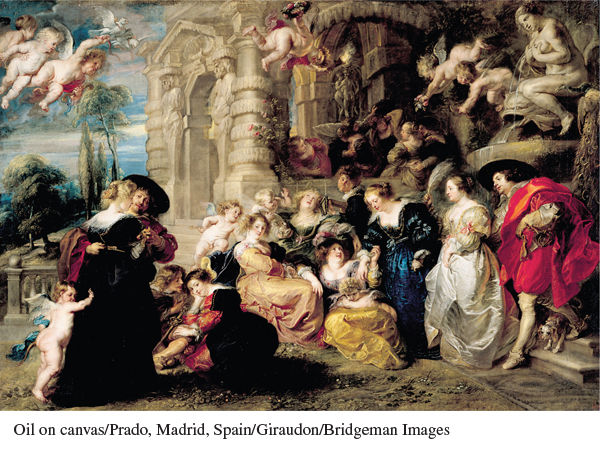A History of Western Society: Printed Page 499
A History of Western Society, Value Edition: Printed Page 483
A History of Western Society, Concise Edition: Printed Page 500
Baroque Art and Music
Throughout European history, the cultural tastes of one age have often seemed unsatisfactory to the next. So it was with the baroque. The term baroque may have come from the Portuguese word for an “odd-
Rome and the revitalized Catholic Church of the late sixteenth century spurred the early development of the baroque. The papacy and the Jesuits encouraged the growth of an intensely emotional, exuberant art. These patrons wanted artists to go beyond the Renaissance focus on pleasing a small, wealthy cultural elite. They wanted artists to appeal to the senses and thereby touch the souls and kindle the faith of ordinary churchgoers while proclaiming the power and confidence of the reformed Catholic Church. In addition to this underlying religious emotionalism, the baroque drew its sense of drama, motion, and ceaseless striving from the Catholic Reformation. The interior of the famous Jesuit Church of Jesus in Rome — the Gesù — combined all these characteristics in its lavish, wildly active decorations and frescoes.
Taking definite shape in Italy after 1600, the baroque style in the visual arts developed with exceptional vigor in Catholic countries — in Spain and Latin America, Austria, southern Germany, and Poland. Yet baroque art was more than just “Catholic art” in the seventeenth century and the first half of the eighteenth. True, neither Protestant England nor the Netherlands ever came fully under the spell of the baroque, but neither did Catholic France. And Protestants accounted for some of the finest examples of baroque style, especially in music. The baroque style spread partly because its tension and bombast spoke to an agitated age that was experiencing great violence and controversy in politics and religion.
In painting, the baroque reached maturity early with Peter Paul Rubens (1577–1640), the most outstanding and most representative of baroque painters. Studying in his native Flanders and in Italy, where he was influenced by masters of the High Renaissance such as Michelangelo, Rubens developed his own rich, sensuous, colorful style, which was characterized by animated figures, melodramatic contrasts, and monumental size. Rubens excelled in glorifying monarchs such as Queen Mother Marie de’ Medici of France. He was also a devout Catholic; nearly half of his pictures treat Christian subjects. Yet one of Rubens’s trademarks was the fleshy, sensual nudes who populate his canvases as Roman goddesses, water nymphs, and remarkably voluptuous saints and angels.

In music, the baroque style reached its culmination almost a century later in the dynamic, soaring lines of the endlessly inventive Johann Sebastian Bach (1685–1750). Organist and choirmaster of several Lutheran churches across Germany, Bach was equally at home writing secular concertos and sublime religious cantatas. Bach’s organ music combined the baroque spirit of invention, tension, and emotion in an unforgettable striving toward the infinite. Unlike Rubens, Bach was not fully appreciated in his lifetime, but since the early nineteenth century his reputation has grown steadily.